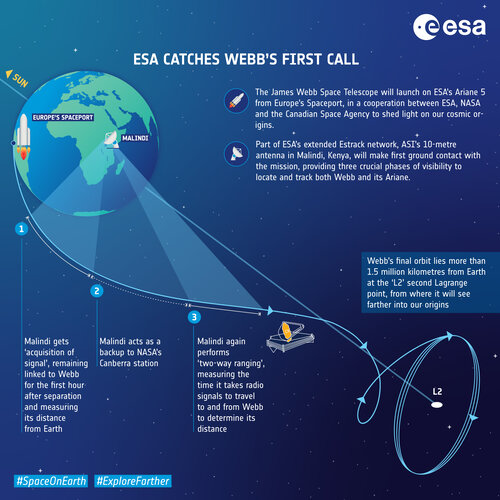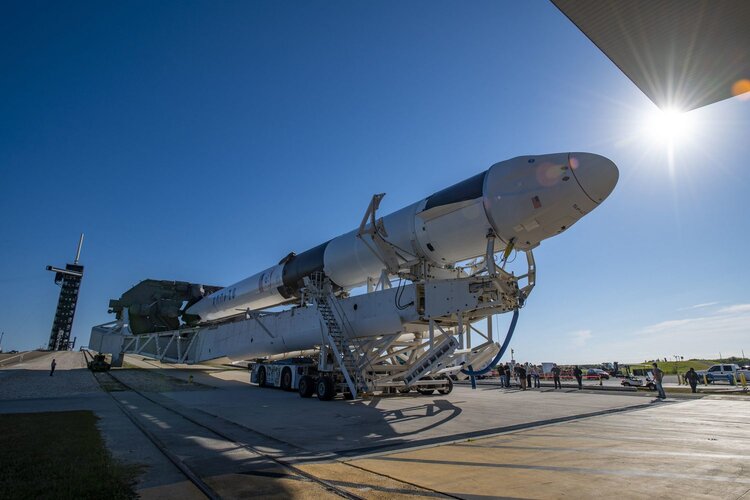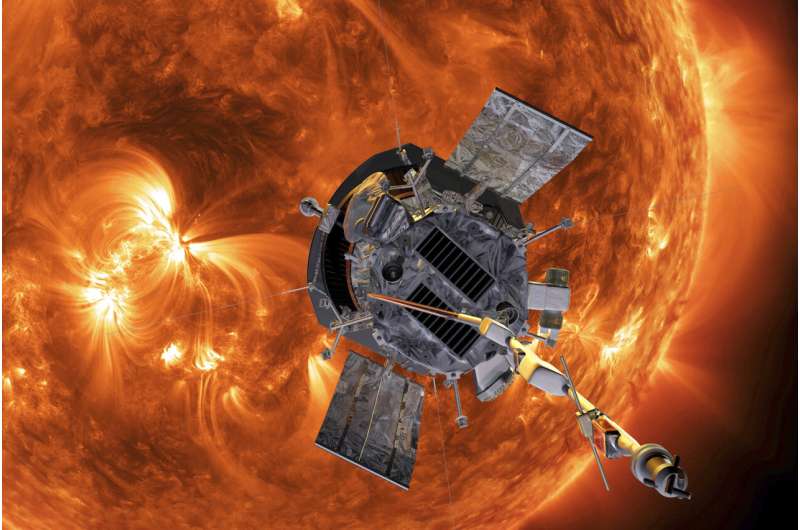ESA catches Webb's first call
Monday, 20 December 2021 09:35 Image:
Image:
Webb is due to launch on an Ariane 5 rocket from Europe’s Spaceport in French Guiana, at the earliest on 24 December. It will journey on a direct escape trajectory towards its target orbit more than 1.5 million kilometres from Earth. Part of ESA’s Estrack cooperative network, the 10-metre antenna in Malindi, Kenya, will make first contact from the ground with the fledgling mission, with the all-important ‘first acquisition of signal’.
About 23 minutes after lift-off, Malindi will locate the Ariane 5 launch vehicle in flight, rising above the Western horizon, still housing its precious cargo. Only five minutes later,
Dragon delivery – European science destined for space
Monday, 20 December 2021 08:42
The next SpaceX resupply vehicle is packed with European science, ready for delivery to the International Space Station just in time for Christmas.
Japanese space tourists safely return to Earth
Monday, 20 December 2021 07:57
Japanese space tourists return to Earth after 12 days on ISS
Monday, 20 December 2021 05:16 A Japanese billionaire returned to Earth Monday, after 12 days spent on the International Space Station where he made videos about performing mundane tasks in space including brushing teeth and going to the bathroom.
Online fashion tycoon Yusaku Maezawa and his assistant Yozo Hirano parachuted onto Kazakhstan's steppe at around the expected landing time of 0313 GMT Monday, along with Russia
A Japanese billionaire returned to Earth Monday, after 12 days spent on the International Space Station where he made videos about performing mundane tasks in space including brushing teeth and going to the bathroom.
Online fashion tycoon Yusaku Maezawa and his assistant Yozo Hirano parachuted onto Kazakhstan's steppe at around the expected landing time of 0313 GMT Monday, along with Russia NASA craft 'touches' sun for 1st time, dives into atmosphere
Sunday, 19 December 2021 16:00
Russia ready to 'fight' for space tourism supremacy
Sunday, 19 December 2021 09:00 After a decade-long hiatus, Russia is relaunching an ambitious bid for dominion over the world's budding space tourism industry, jostling with zealous billionaires, the United States, and rising China.
Russia flaunted its comeback this month dispatching two cosmic adventurers - Japanese billionaire Yusaku Maezawa and his assistant - to the International Space Station (ISS) in its first lau
After a decade-long hiatus, Russia is relaunching an ambitious bid for dominion over the world's budding space tourism industry, jostling with zealous billionaires, the United States, and rising China.
Russia flaunted its comeback this month dispatching two cosmic adventurers - Japanese billionaire Yusaku Maezawa and his assistant - to the International Space Station (ISS) in its first lau Raytheon Intelligence and Space to build Space Force weather satellite prototype
Sunday, 19 December 2021 09:00 Raytheon Intelligence and Space, a Raytheon Technologies business, has been awarded a $67 million contract to demonstrate an Electro-Optical Infrared Weather System, or EWS, Prototype with the ability to deliver operational data for the U.S. Space Force's Space Systems Command under an Other Transaction Authority contract. A successful prototype demonstration will provide Electro-optical/Infrare
Raytheon Intelligence and Space, a Raytheon Technologies business, has been awarded a $67 million contract to demonstrate an Electro-Optical Infrared Weather System, or EWS, Prototype with the ability to deliver operational data for the U.S. Space Force's Space Systems Command under an Other Transaction Authority contract. A successful prototype demonstration will provide Electro-optical/Infrare NCAR's mini-satellite to measure howling winds high in atmosphere
Sunday, 19 December 2021 09:00 The National Center for Atmospheric Research (NCAR) has received $6.5 million in funding from NASA to launch a roughly shoebox-sized satellite into space carrying an instrument designed to measure the howling thermospheric winds, which can gust more than 300 miles per hour through the highest reaches of the Earth's atmosphere.
The blustery winds in the thermosphere - the upper layer of the
The National Center for Atmospheric Research (NCAR) has received $6.5 million in funding from NASA to launch a roughly shoebox-sized satellite into space carrying an instrument designed to measure the howling thermospheric winds, which can gust more than 300 miles per hour through the highest reaches of the Earth's atmosphere.
The blustery winds in the thermosphere - the upper layer of the China Pursues Helium-3 on the Moon
Sunday, 19 December 2021 09:00 Apparently, China sees the Moon as a future source of fuel for terrestrial power and space dominance. At the moment Chinese nuclear scientists are studying lunar surface material samples brought back by its Chang'e 5 lunar exploration mission late last year. One sample is believed to contain helium-3, an isotope.
This particular isotope is very rare on Earth, but thought to be abundant in
Apparently, China sees the Moon as a future source of fuel for terrestrial power and space dominance. At the moment Chinese nuclear scientists are studying lunar surface material samples brought back by its Chang'e 5 lunar exploration mission late last year. One sample is believed to contain helium-3, an isotope.
This particular isotope is very rare on Earth, but thought to be abundant in Northrop Grumman completes environmental testing for Next Gen OPIR GEO payload
Sunday, 19 December 2021 09:00 The Northrop Grumman Corporation and Ball Aerospace team successfully achieved three critical milestones on production of its Next Generation Overhead Persistent Infrared (Next Gen OPIR) Geosynchronous Earth Orbit (GEO) Engineering Development Unit (EDU) payload. The missile warning sensor payload is being developed for the U.S. Space Force's GEO missile warning satellites built by spacecraft pr
The Northrop Grumman Corporation and Ball Aerospace team successfully achieved three critical milestones on production of its Next Generation Overhead Persistent Infrared (Next Gen OPIR) Geosynchronous Earth Orbit (GEO) Engineering Development Unit (EDU) payload. The missile warning sensor payload is being developed for the U.S. Space Force's GEO missile warning satellites built by spacecraft pr Space-bound research a step toward feeding Earth's people
Sunday, 19 December 2021 09:00 Clemson researcher Chris Saski admits sending the University's iconic Tiger Paw to space aboard a SpaceX Dragon spacecraft is, quite literally, "an out-of-this-world experience."
But it's the potential for the experiments in the flight hardware to which the Paw is attached that truly excites him.
Saski's cotton regeneration research, adorned with Clemson stickers, intends to take off
Clemson researcher Chris Saski admits sending the University's iconic Tiger Paw to space aboard a SpaceX Dragon spacecraft is, quite literally, "an out-of-this-world experience."
But it's the potential for the experiments in the flight hardware to which the Paw is attached that truly excites him.
Saski's cotton regeneration research, adorned with Clemson stickers, intends to take off NOAA's Arctic report card finds 'alarming' trend in climate crisis
Sunday, 19 December 2021 09:00 The National Oceanic and Atmospheric Administration's 2021 Arctic report card shows a region transformed by human-caused climate change, a thawing of a once reliably frozen region.
"The Arctic Report Card continues to show how the impacts of human-caused climate change are propelling the Arctic region into a dramatically different state than it was in just a few decades ago," said NOAA
The National Oceanic and Atmospheric Administration's 2021 Arctic report card shows a region transformed by human-caused climate change, a thawing of a once reliably frozen region.
"The Arctic Report Card continues to show how the impacts of human-caused climate change are propelling the Arctic region into a dramatically different state than it was in just a few decades ago," said NOAA New research explains Earth's peculiar chemical composition
Sunday, 19 December 2021 09:00 Earth's surface environment hosts large reservoirs of hydrogen (H, mainly in the form of water, H2O), nitrogen (in atmospheric N2) and carbon (mainly in carbonate rocks). H, N and C are sometimes called "volatile" elements, or simply "volatiles," by geoscientists because many of the simple compounds they form are gases at standard temperature and pressure. However, the distribution of these vola
Earth's surface environment hosts large reservoirs of hydrogen (H, mainly in the form of water, H2O), nitrogen (in atmospheric N2) and carbon (mainly in carbonate rocks). H, N and C are sometimes called "volatile" elements, or simply "volatiles," by geoscientists because many of the simple compounds they form are gases at standard temperature and pressure. However, the distribution of these vola New copper surface eliminates bacteria in just two minutes
Sunday, 19 December 2021 09:00 A new copper surface that kills bacteria more than 100 times faster and more effectively than standard copper could help combat the growing threat of antibiotic-resistant superbugs.
The new copper product is the result of a collaborative research project with RMIT University and Australia's national science agency, CSIRO, with findings just published in Biomaterials.
Copper has long
A new copper surface that kills bacteria more than 100 times faster and more effectively than standard copper could help combat the growing threat of antibiotic-resistant superbugs.
The new copper product is the result of a collaborative research project with RMIT University and Australia's national science agency, CSIRO, with findings just published in Biomaterials.
Copper has long 'Alarm bells' as UN validates record Arctic temperature
Sunday, 19 December 2021 09:00 The UN on Tuesday officially recognised the 38 degrees Celsius measured in Siberia last year as a new record high for the Arctic, sounding "alarm bells" over climate change.
The sweltering heat - equivalent to 100.4 degrees Fahrenheit - was seen on June 20, 2020 in the Russian town of Verkhoyansk, marking the highest temperature ever recorded above the Arctic Circle, the World Meteorologic
The UN on Tuesday officially recognised the 38 degrees Celsius measured in Siberia last year as a new record high for the Arctic, sounding "alarm bells" over climate change.
The sweltering heat - equivalent to 100.4 degrees Fahrenheit - was seen on June 20, 2020 in the Russian town of Verkhoyansk, marking the highest temperature ever recorded above the Arctic Circle, the World Meteorologic 
